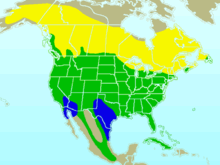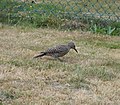Northern flicker
| Northern Flicker | |
|---|---|

| |
| Scientific classification | |
| Kingdom: | |
| Phylum: | |
| Class: | |
| Order: | |
| Family: | |
| Genus: | |
| Species: | C. auratus
|
| Binomial name | |
| Colaptes auratus (Linnaeus, 1758)
| |

| |
The Northern Flicker (Colaptes auratus) is a medium-sized member of the woodpecker family. It is native to most of North America, parts of Central America, Cuba, the Cayman Islands, and is one of the few woodpecker species that migrate. It is the only woodpecker that commonly feeds on the ground. There are over 100 common names for the Northern Flicker. Among them are: Yellowhammer, clape, gaffer woodpecker, harry-wicket, heigh-ho, wake-up, walk-up, wick-up, yarrup, and gawker bird. Many of these names are attempts at imitating some of its calls.
Taxonomy
The Northern Flicker is part of the genus Colaptes which encompasses 12 New-World woodpeckers. There are two living and one extinct subspecies of C. auratus species. The existing sub-species were at one time considered separate species but they commonly interbreed where ranges overlap and are now considered one species by the American Ornithologists Union. Whether or not they are separate species is a well-known example of the species problem.
- The Yellow-shafted Flicker Colaptes auratus resides in eastern North America. They are yellow under the tail and underwings and have yellow shafts on their primaries. They have a grey cap, a beige face and a red bar at the nape of their neck. Males have a black moustache. Colaptes comes from the Greek verb colapt, to peck. Auratus is from the Latin root aurat, meaning "gold" or "golden" and refers to the bird's underwing.
- Under the name "Yellowhammer" it is the state bird of Alabama.[2]
- The Red-shafted Flicker Colaptes auratus cafer resides in western North America. They are red under the tail and underwings and have red shafts on their primaries. They have a beige cap and a grey face. Males have a red moustache. The scientific name, Colaptes auratus cafer, is the result of an error made in 1788 by the German systematist, Johann Gmelin, who believed that its original habitat was in South Africa among the Xhosa people, then known as the "Kaffir" people. (The term "Kaffir" is now considered an extreme ethnic slur in South Africa.)
- The Guadalupe Flicker Colaptes auratus/cafer rufipileus extinct c. 1910.
Description

Adults are brown with black bars on the back and wings and measure approximately 32 cm (12.5 inches) in length. The wingspan is approximately 17 to 20 inches. A necklace-like black patch occupies the upper breast, while the lower breast and belly are beige with black spots. Males can be identified by a black or red moustachial stripe at the base of the beak. The tail is dark on top, transitioning to a white rump which is conspicuous in flight.
The subspecies plumage varies as described in Taxonomy section.
Call and flight
This bird's call is a sustained laugh, ki ki ki ki ..., more congenial than that of the Pileated Woodpecker. One may also hear a constant knocking as they often drum on trees or even metal objects to declare territory. Like most woodpeckers, Northern Flickers drum on objects as a form of communication and territory defense. In such cases, the object is to make as loud a noise as possible, and that’s why woodpeckers sometimes drum on metal objects. One Northern Flicker in Wyoming could be heard drumming on an abandoned tractor from a half-mile away.
Like many woodpeckers, its flight is undulating. The repeated cycle of a quick succession of flaps followed by a pause creates an effect comparable to a rollercoaster.
Behavior
Diet
According to the Audubon guide, "flickers are the only woodpeckers that frequently feed on the ground", probing with their beak, also sometimes catching insects in flight. Although they eat fruits, berries, seeds and nuts, their primary food is insects. Ants alone can make up 45% of their diet. They have a behavior called anting, during which they use the acid from the ants to assist in preening, as it is useful in keeping them free of parasites. Northern Flickers eat mainly insects, especially ants and beetles that they gather from the ground. They also eat fruits and seeds, especially in winter. Flickers often go after ants underground (where the nutritious larvae live), hammering at the soil the way other woodpeckers drill into wood. They’ve been seen breaking into cow patties to eat insects living within. Their tongues can dart out 2 inches beyond the end of the bill to snare prey. Other invertebrates eaten include flies, butterflies, moths, and snails. Flickers also eat berries and seeds, especially in winter, including poison oak and ivy, dogwood, sumac, wild cherry and grape, bayberries, hackberries, and elderberries, and sunflower and thistle seeds.
Habitat
Look for flickers in open habitats near trees, including woodlands, edges, yards, and parks. In the West you can find them in mountain forests all the way up to treeline. Northern Flickers generally nest in holes in trees like other woodpeckers. Occasionally, they’ve been found nesting in old, earthen burrows vacated by Belted Kingfishers or Bank Swallows. Both sexes help with nest excavation. The entrance hole is about 3 inches in diameter, and the cavity is 13-16 inches deep. The cavity widens at bottom to make room for eggs and the incubating adult. Inside, the cavity is bare except for a bed of wood chips for the eggs and chicks to rest on. Once nestlings are about 17 days old, they begin clinging to the cavity wall rather than lying on the floor.
Lifespan
The oldest known "yellow-shafted" Northern Flicker lived to be at least 9 years 2 months old, and the oldest “red-shafted” Northern Flicker lived to be at least 8 years 9 months old.
Reproduction

Their breeding habitat consists of forested areas across North America and as far south as Central America. They are cavity nesters who typically nest in trees though they will also use posts and birdhouses if sized and situated appropriately. They prefer to excavate their own home though they will reuse and repair damaged or abandoned nests. Abandoned flicker nests create habitat for other cavity nesters. Flickers are sometimes driven from nesting sites by another cavity nester, European starlings.
It takes about 1 to 2 weeks to build the nest which is built by both sexes of the mating pairs. The entrance hole is roughly 5 cm to 10 cm wide.

A typical clutch consists of 6 to 8 eggs whose shells are pure white with a smooth surface and high gloss. The eggs are the second largest of the North American woodpecker species, exceeded only by the Pileated Woodpecker's. Incubation is by both sexes for approximately 11 to 12 days. The young are fed by regurgitation and fledge about 25 to 28 days after hatching.
Wintering and migration
Northern birds migrate to the southern parts of the range; southern birds are often permanent residents.
Photos
-
Male Red-shafted Flicker
-
Male Red-shafted Flicker
-
Yellow-shafted Flicker
-
Male Red-shafted Flicker
-
Male Yellow-shafted Flicker
-
Intergrade Northern Flickers
-
Male flicker at nest box
-
Female flicker at nest box
-
Flicker chicks at nest box
-
Yellow-shafted Flicker (observe the yellow undersides of his wings)
-
Male, Yellow-shafted Flicker
Footnotes
- ^ Template:IUCN2007 Database entry includes justification for why this species is of least concern
- ^ "Alabama State Bird". Alabama Emblems, Symbols and Honors. Alabama Department of Archives & History. 2006-04-27. Retrieved 2007-03-18.
External links
- Northern Flicker original page gone, maybe look at the maindomain http://ca.oocities.com/woodpeck2006, a bibliographic source
- Northern Flicker Species Account - Cornell Lab of Ornithology
- Northern Flicker - Colaptes auratus - USGS Patuxent Bird Identification InfoCenter
- Northern Flicker Information and Photos - South Dakota Birds and Birding
- A sample of the call of a Northern Flicker by the USGS
- Stamps (for Antigua, Cayman Island, Cuba, Saint Pierre and Miquelon, United States) (imperfect RangeMap)
- Northern Flicker videos on the Internet Bird Collection
- Northern Flicker photo gallery VIREO
- Calls of the Northern Flicker
- Northern (Yellow-shafted) Flicker Bird Sound
- IUCN Red List least concern species
- Woodpeckers
- Colaptes
- United States state birds
- Birds of North America
- Birds of Canada
- Birds of the United States
- Native birds of Alaska
- Birds of Mexico
- Birds of Guatemala
- Birds of El Salvador
- Birds of Honduras
- Birds of Nicaragua
- Birds of Saint Pierre and Miquelon
- Birds of Cuba
- Birds of the Cayman Islands
- North American migratory birds












